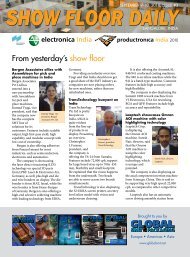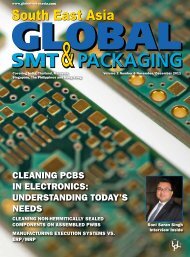South East Asia - WordPress.com - BluOcean.AdMedia
South East Asia - WordPress.com - BluOcean.AdMedia
South East Asia - WordPress.com - BluOcean.AdMedia
Create successful ePaper yourself
Turn your PDF publications into a flip-book with our unique Google optimized e-Paper software.
efficient thermally conductive copper<br />
clad aluminum laminate substrate by the<br />
PCB fabricator themselves (Figure 1) or<br />
could used by selectively printing both the<br />
dielectric and conductive traces to make<br />
a thermally conductive circuit by anyone<br />
with a silk screen printer and a thermal<br />
oven (See Figure 3).<br />
Using CCD-120A thermally conductive<br />
dielectric ink with its nano technology<br />
enhanced formulation in making<br />
PCB boards or even making copper clad<br />
aluminum circuit laminate will deliver<br />
lower thermal resistance than that of other<br />
currently available copper clad aluminum<br />
substrates.<br />
copper-clad aluminum<br />
The thermally conductive B-stage ink<br />
is applied to the surface of either the<br />
copper foil or the aluminum and is semi<br />
cured (B-Stage) using a thermal oven.<br />
Application is typically a silk screening<br />
operation to deposit a thin film of thermal<br />
ink approximately .001” thick. The ink is<br />
then baked at 250˚F for 20-30 minutes, at<br />
which time the material reaches the desired<br />
Figure 4. Heat radiating <strong>com</strong>parison.<br />
www.globalsmtindia.in<br />
B-stage cure.<br />
The coated B-stage aluminum is laminated<br />
with the copper foil of choice using a<br />
typical vacuum-assist laminating press and<br />
fully cured under pressure.<br />
The end result is a thin layer only<br />
25 microns thick of the thermal material<br />
sandwiched between the copper and<br />
aluminum. With this version of a copper<br />
clad aluminum, the B stage thermal ink<br />
offers lower thermal resistance, because<br />
the surface area contact and the thickness<br />
of the deposit. As well, the pressure<br />
of the lamination cycle constricts the ink<br />
allowing a closer contact between thermally<br />
conductive ceramic particles increasing the<br />
thermal conductance. A one mil thick layer<br />
of thermal ink properly applied has a 2500<br />
volt rating.<br />
Processing the panel to make a<br />
simple single-sided circuit is a done by the<br />
time-honored “print and etch” method<br />
requiring PCB fabrication equipment and<br />
wastewater treatment facilities because of<br />
the copper etching process.<br />
Figure 2 shows the etched circuit trace<br />
paths on the Thermally Conductive dielec-<br />
PEC (printed electronic circuit) process for LED interconnection<br />
Figure 3. Silver trace on selective print thermal<br />
dielectric.<br />
tric. Adhesion to aluminum with our 2 w/<br />
mc ink is excellent; the thermal dielectric<br />
has a hard surface due to its high ceramic<br />
content but can accept a coat of soldermask<br />
before the final cure. A <strong>com</strong>patible<br />
solder mask could later be applied.<br />
print-only circuits<br />
A selectively deposited thermal conductive<br />
ink on the aluminum offers the benefit of<br />
being deposited only where thermal heat<br />
transfer is needed, reducing consumables<br />
costs when <strong>com</strong>pared to the currently<br />
popular copper clad aluminum substrate,<br />
which has full coverage of the underlying<br />
surface with the glass cloth impregnated<br />
with heat conductive material.<br />
The circuit traces are screened on<br />
Global SMT & Packaging <strong>South</strong>east <strong>Asia</strong> – Winter 2010 – 11









